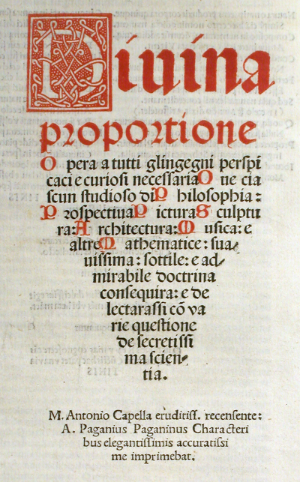'divine proportion'

In 1498 Pacioli writes the book Divina Proportione.
In 1509 a printed version is edited, with drawings by Leonardo da Vinci. Online you can read it in facsimile.
In the first part, Compendio divina proportione (Compendium about the divina proportion) Pacioli writes about the mathematical proportions and their applications in geometry, art and architecture.
Remarkable is that Pacioli doesn't write 'golden section' but 'divine proportion'.
Ever more remarkable are the reasons to use this term.
- Its value stands for the divine simplicity.
- Its definitions points to 3 lengths, symbol for the Holy Trinity.
- Its irrationality stands for the incomprehensibility of God.
- The immutability: As God is omnipresent and in avery part and whole, the proportion is always the same, regardless the absolute length of the separate parts involved.
- Its relation with the dodecahedron points to the quintessece. In philosophy the quintessence was the fifth, immaterial element. You can inscribe the other 4 Platonisc solids into an icosahedron, as God gives live to the other vier elements.